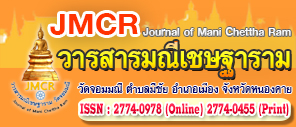การตรวจสอบสามเส้าในการวิจัยทางสังคมศาสตร์
คำสำคัญ:
การตรวจสอบสามเส้า, การวิจัยทางสังคมศาสตร์, การวิเคราะห์หลายมิติบทคัดย่อ
บทความนี้ศึกษาแนวคิดการตรวจสอบสามเส้า (Triangulation) ในการวิจัยทางสังคมศาสตร์ ซึ่งเป็นเครื่องมือสำคัญในการเพิ่มความน่าเชื่อถือและความถูกต้องของงานวิจัย โดยการใช้วิธีการที่หลากหลายหรือแหล่งข้อมูลที่แตกต่างกันเพื่อลดความลำเอียงและเพิ่มความครอบคลุมของผลการวิจัย การตรวจสอบสามเส้าแบ่งออกได้เป็นสี่ประเภทหลัก ได้แก่ การตรวจสอบสามเส้าของข้อมูล (Data Triangulation) การตรวจสอบสามเส้าของวิธีการ (Methodological Triangulation) การตรวจสอบสามเส้าของนักวิจัย (Investigator Triangulation) และการตรวจสอบสามเส้าของทฤษฎี (Theoretical Triangulation) บทความนี้นำเสนอประโยชน์และข้อจำกัดของแต่ละประเภท และยกตัวอย่างการนำไปใช้ในงานวิจัยทางสังคมศาสตร์เพื่อเพิ่มความลึกซึ้งในการวิเคราะห์และการยืนยันผลลัพธ์ของงานวิจัย
เอกสารอ้างอิง
Bans-Akutey, A., and Tiimub, B.M. (2021). Triangulation in Research. Retrieved on October 14, 2024, from https://www.researchgate.net/profile/Benjamin-Tiimub-2/publication/ 355425953_Triangulation_in_Research/links/616fd0f1b148a924b8013beb/Triangulation-in-Research.pdf
Blaikie, N.W.H. (1991). A critique of the use of triangulation in social research. Quality & Quantity, 23, 115-136.
Bryman, A. (2004). Triangulation and measurement. Retrieved on October 14, 2024, from https://d1wqtxts1xzle7.cloudfront.net/33017986/Triangulation-libre.pdf
Carter, N., Bryant-Lukosius, D., DiCenso, A, Blythe, J., and Neville, A. J. (2014). The Use of Triangulation in Qualitative Research. Oncology Nursing Forum, 41(5), 545-547.
Creswell, J. W. (2013). Qualitative inquiry and research design: Choosing among five approaches (3rd ed.). Sage Publications.
Denzin, N. K. (1978). The sociological method: A sourcebook. McGraw-Hill.
Fielding, N.G., and Schreier, M. (2001). Introduction: On the Compatibility between Qualitative and Quantitative Research Methods. Forum: Qualitative Social Research.
Jick, T. D. (1979). Mixing qualitative and quantitative methods: Triangulation in action. Administrative Science Quarterly, 24(4), 602-611.
Mathison, S. (1988). Why Triangulate? Educational Researcher, 17(2), 13-17.
McFee, G. (1992). Triangulation in research: Two confusions. Educational Research, 34(3), 215-219.
Patton, M. Q. (1999). Enhancing the quality and credibility of qualitative analysis. Health Services Research.




